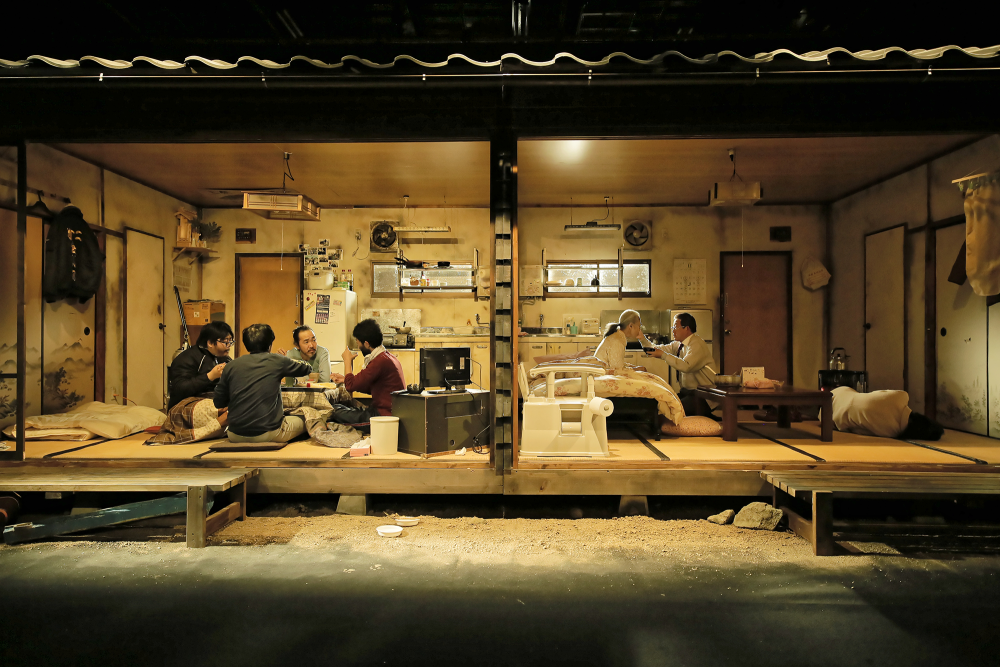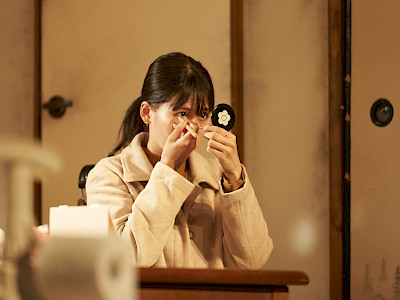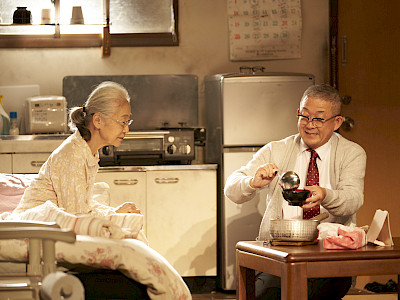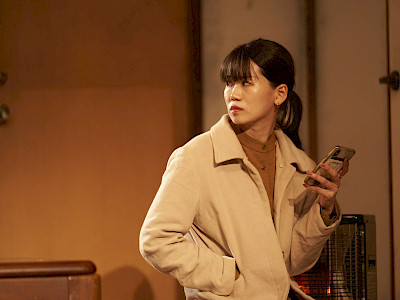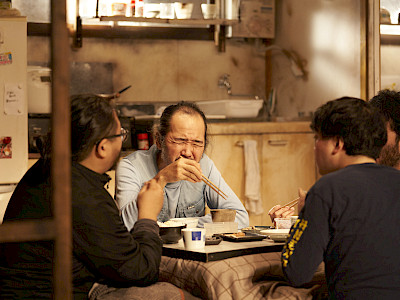17 — 20.05.2023
In our high-tech era of social networks, we have the impression that everything is linked, yet we often miss the opportunity to really get to know the other. In Egao no Toride (Fortress of Smiles), two adjacent apartments symbolise this situation in modern society: a thin wall separating contrasting lives. On one side, we see a group of cheerful hedonists; on the other, a taciturn family dealing with the silent creep of dementia and infirmity. In these close quarters, the symmetrical households influence each other while still living parallel lives. Until something happens. Kurō Tanino, one of the most compelling voices of Japanese theatre – presented for the first time in Belgium – pictures the human soul with humour and a dash of surrealism. As a painter, author, director and psychiatrist, he calls on all of his vocations to produce a unique style. Tanino founded his renowned Niwa Gekidan Penino theatre company while still a student, and they have since toured worldwide. Their plays evoke the spectres of strangeness, loneliness, and difference. Yet they shine a light on the invisible thread connecting our lives, no matter how different they seem to be. In Tanino’s work, the everyday becomes exceptional.
“Our imagination must be free”
Interview with Kurô Tanino
Mélanie Drouère – You attach great importance in your work to the stage design, creating a contrast between a very realistic traditional set and stage “devices” and extremely contemporary contents. What are you looking for with this approach?
Kurô Tanino – I’m always trying to capture moments in which things are going to disappear or be lost. You can even say that it’s the only thing the text and the production have in common. I often use a traditional set because it gives my plays an atmosphere that is disappearing.
There’s always a link between your plays and your personal experiences. What does this new work contain of your private life?
I come from Toyama, which is on the coast of the Sea of Japan. From my house, I could cycle down to the sea and go swimming or fishing. I loved the sea; it was a close and powerful presence for me. This play is connected to my memories of Toyama. I’ve taken most of the names for the characters from my friends there. And, in a line spoken by Takiko, I’ve even quoted what I really heard my grandmother say.
In 慞馹肥鼭 Egao no Toride (The Fortress of Smiles), you contrast on stage the day-to-day life of a family centred on a mother and a sick grandmother with that of a group of fishermen. Why did you choose the world of fishermen?
I chose this setting to emphasise the contrast between noisy and quiet worlds, one happy, the other sorrowful, a working community on the one hand and a family circle on the other, physical work and the situation of looking for a job.
What does this juxtaposition mean of two worlds living under the same roof, separated by just a thin wall?
I designed these two apartments to have an identical format and with a symmetrical layout. The play takes place near the sea where the wind is strong. The building has no upper floor. I wanted to show the influence these apartments have on each other. In everyday life, it’s rare to think that something taking place next door directly affects us. But when you see it in a play, you have to be aware of it. That’s the undeniable effect of theatre. I deliberately limited direct contact between the two dwellings to make the audience sense the richness of the influence that exists in this world without us being aware of it.
The spectre of disease lurks in one of the apartments. Why are you interested you in this subject in particular?
I think that a piece of fiction should show how people change when they come into contact without outside incidents. In my plays, this encounter doesn’t happen in the dialogues between the characters as much as in subtle, non-explicit elements, such as attitudes, actions, silences and voids. It’s precisely the abyss within each character that allows expressions to emerge.
You always introduce a big contrast between “day-to-day life” and what ends up driving a crack through it. In the intention and in the form. Like flashpoints. Can you tell us about that?
In this play, I’ve described the fact that a day-to-day life you think would just carry on can just as easily fall apart as a result of not very much. Our everyday life is fragile. It’s continually changing. I’m not using dramatic events, but small, barely detectable elements that accumulate and unleash a change.
Is this a butterfly effect from one world – here, an apartment – on another, since it seems to have an influence without any causal link? Do you believe in the “butterfly effect”?
That’s exactly it. I believe in the butterfly effect in the sense that it’s impossible to rule out every hypothesis. Not being able to define the cause of an event doesn’t mean there isn’t one. The fact of considering that everything that happens has a cause, that all phenomena are connected, is perhaps close to Buddhist thinking. And I’m not saying that from a spiritual point of view, because personally I don’t consider Buddhism to be a simple religion. I’m attracted by this idea because I see aspects it shares with molecular biology and quantum mechanics. For example, the state of Satori (awakening) much sought-after by Buddhists is often expressed as “emptiness”, “a state in which consciousness no longer exists” or again “a state where fullness and emptiness merge together”. You can say that this touches on what science has designated – for the moment – as a definition of the phenomena of life. Dynamic equilibrium considers that all life is fluid. The fact of breathing and eating allows us to exchange our molecules. Our life exists through these exchanges. In a year, from a molecular perspective we’ll be a different person. Theatre for me is the place for thinking about the fact that we live in a constantly evolving world where everything is connected.
In your opinion, what do theatre’s tools give you so that you can focus on our existences in such a singular way?
Oh, you’re asking me a question that takes us to the art of theatre, aren’t you? I’d like to be perceptive in my answer, but I don’t know if I’ll manage it. First, I think that theatre teaches us that everything exists through relationships with other elements. If all life actually is fluid, then everything can be influenced by other elements. To express this, it’s important for people who create plays to be fully aware of it. During rehearsals, the actors are endlessly curious as they reflect on why they’re there. I think that a director’s work consists of stimulating this state, the inner state of the creative team. Its visible expression follows. I want my plays to be performed in a way that is in keeping with this principal state.
Why the title The Fortress of Smiles?
A fortress is like a military base: even if it’s small, it protects you from outside enemies. Here I put two fortresses side by side: Takeshi’s with his fishing friends, and Tsutomu’s with his family. Both want to have their day-to-day lives accompanied by smiles. Even if life isn’t simple, the very least they want to do is protect it.
- Interviewed in 2020 by Mélanie Drouère for the Festival d’Automne à Paris.
- Translated from Japanese by Aya Soejima.
Presentation: Kunstenfestivaldesarts, Théâtre Varia
Directed and written by: Kurō Tanino | With: Susumu Ogata, Kazuya Inoue, Koichiro F.O. Pereira, Masato Nomura, Hatsune Sakai, Masayuki Mantani, Natsue Hyakumoto | Stage managers: Masaya Natsume, Yuhi Kobayashi | Director’s assistants: Haruka Kikuchi, Kodachi Kitagata | Scenography: Takuya Kamiike | Light design: Masayuki Abe | Light Operateur: Risa Noguchi | Sound design: Koji Shiina | Tour managers: Chika Onozuka, Shimizu Tsubasa
With the support of the Agency of Cultural Affairs of the Government of Japan
Performances in Brussels with the support of The Saison Foundation
